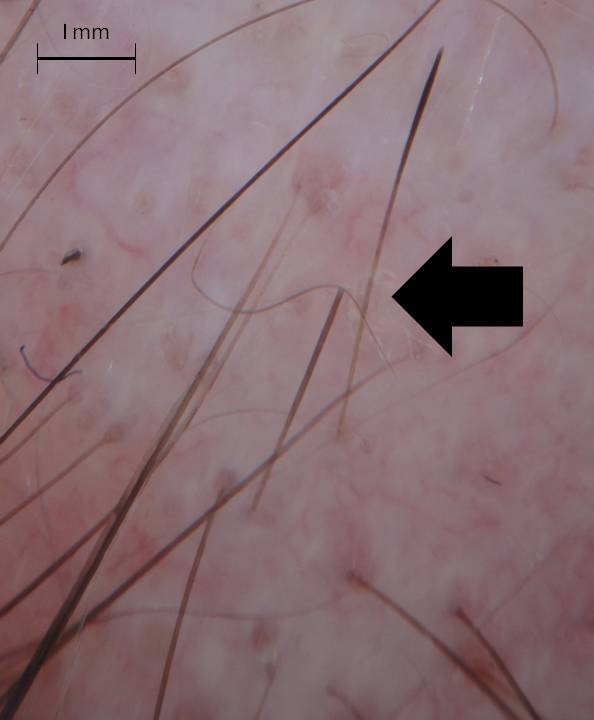Exclamation Mark Hairs
4 mm "exclamation mark" hairs in a patient with alopecia areata
The cause of a patient’s hair loss can sometimes be diagnosed within 2-3 seconds of meeting the patient. On other occasions, it can only be diagnosed by carefully listening to the patient’s history, performing a biopsy or blood work, or by sleuthing through evidence on the scalp with a special magnifying glass (dermatoscope). I often tell my patients that diagnosing hair loss is like “detective work”.
Take the photo on the right for example. It shows a remarkable feature – the so called “exclamation mark” hair. As soon as I see this finding, I know that the patient likely has one diagnosis: alopecia areata.
What is alopecia areata?
Alopecia areata is an autoimmune disease affecting about 2 % of the population. Men and women are equally affected. The disease starts before the age of 18 in about one-half of patients. The disease can cause hair loss in coin-shaped circular patches of hair loss, or it can lead to total loss of scalp hair (alopecia totalis) or total loss of all hair on the body (alopecia universalis). Other patterns of hair loss are also possible in patients with the condition.
What do exclamation mark hairs look like?
Exclamation mark hairs receive their name because they resemble an exclamation mark used in punctuating a sentence. They appear as very small 3-4 mm hairs and are typically wider at the top and then taper to a progressively thinner hair as the hair meets the scalp. Exclamation mark hairs typically appear pale at the bottom and darker at the top.
Why do exclamation mark hairs occur?
It’s not entirely clear why exclamation mark hairs are produced. However, it seems that the main reason is because of inflammation. In alopecia areata, inflammation occurs at the very bottom of the hair fiber deep under the skin. Because of this inflammation, the hair becomes progressively thinned and accumulates many weak spots all along the hair shaft. These weak spots lead to the hair breaking or fracturing easily. Because of this breakage, only short hair fibers (less than 3-4 mm) are produced.
Why do I consider exclamation mark hairs to be so important?
1) If a patient has exclamation mark hairs, I can be extremely confident that the diagnosis is alopecia areata. These hairs tend to be present in the early stages of alopecia areata and occur at the edges of an area of hair loss. Exclamation mark hairs very rarely occur in other situations, (such as poisoning with thallium), but those situations are very rare.
2) The presence of these hairs tells me that the patient’s disease is active and that it is quite likely that the patient’s area of hair loss will increase in size over the next few weeks.
Not every patient with alopecia areata has exclamation mark hairs. However, when this finding is present, I am confident that my detective work is complete and a diagnosis of alopecia areata can be rendered.
This article was written by Dr. Jeff Donovan, a Canadian and US board certified dermatologist specializing exclusively in hair loss.

